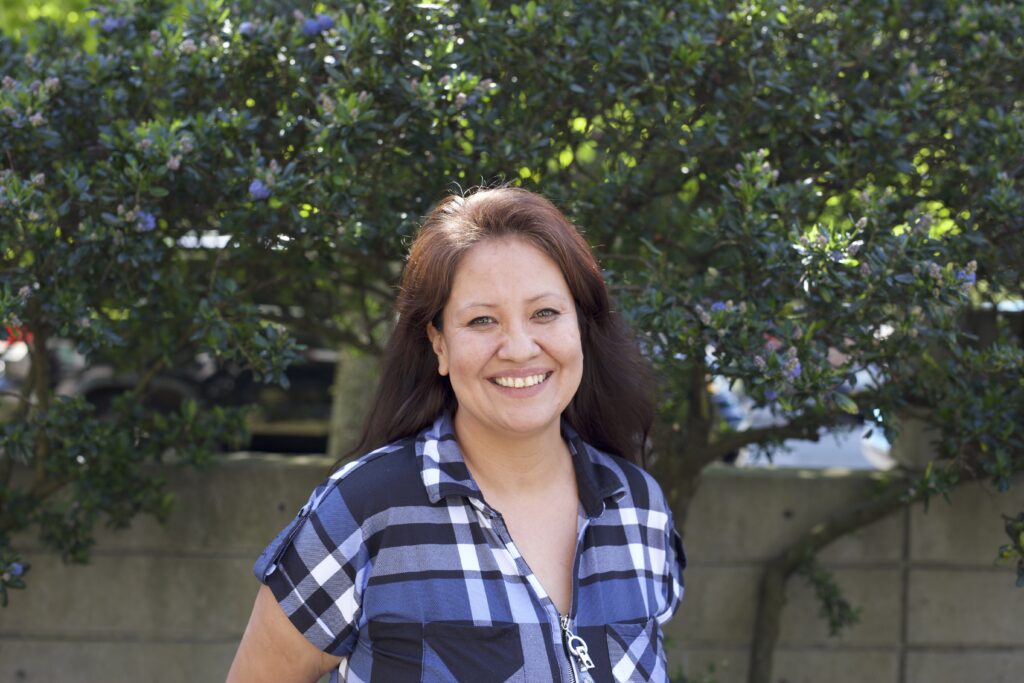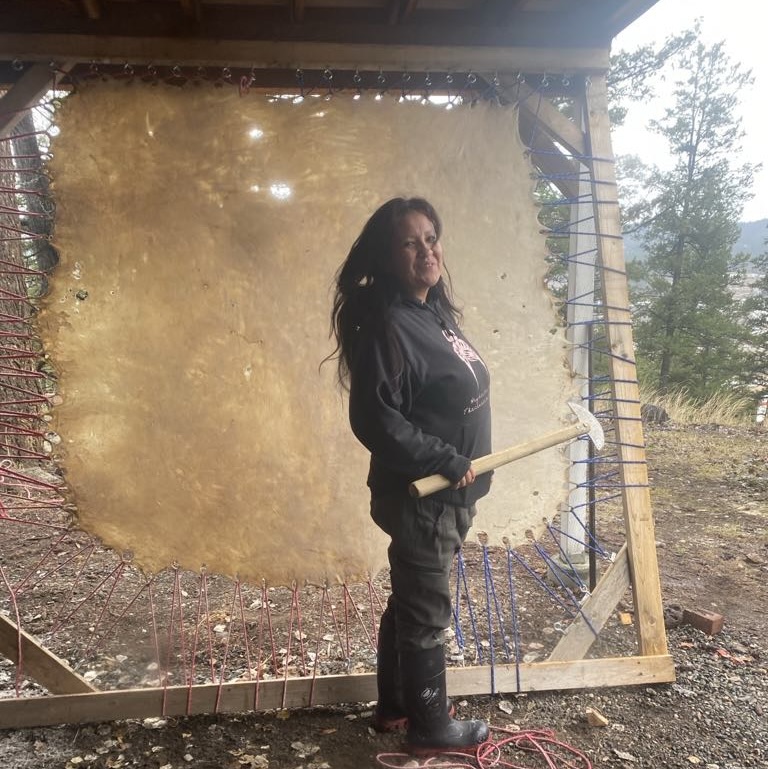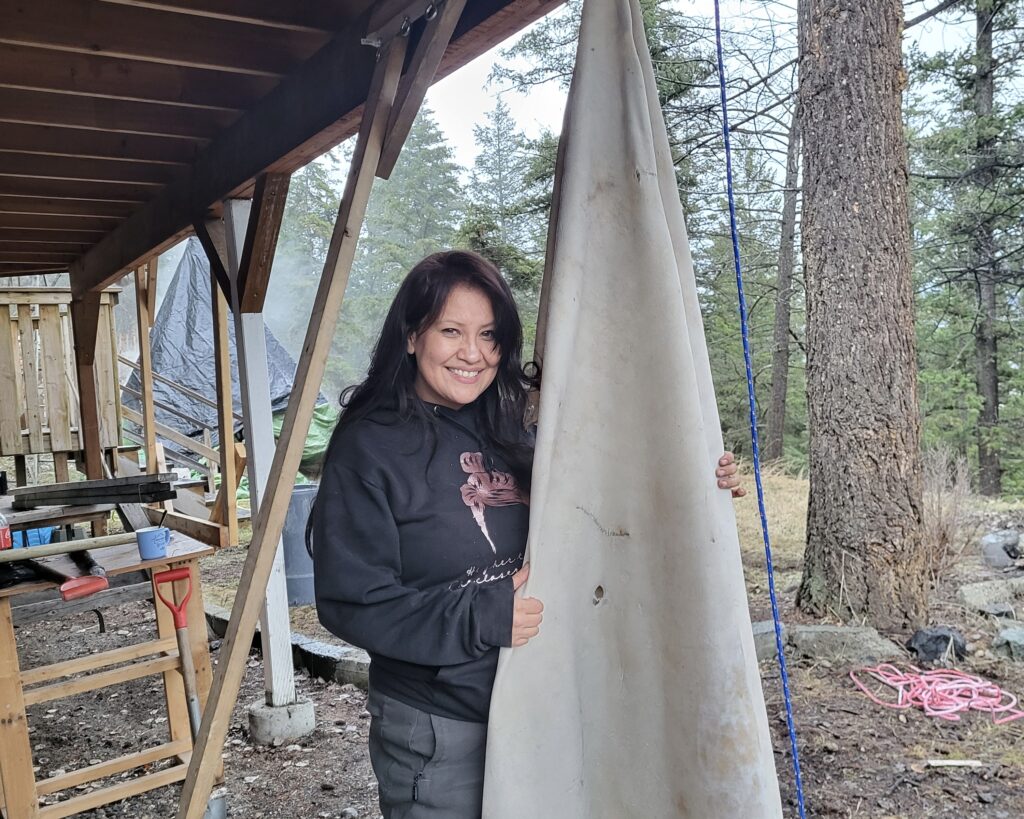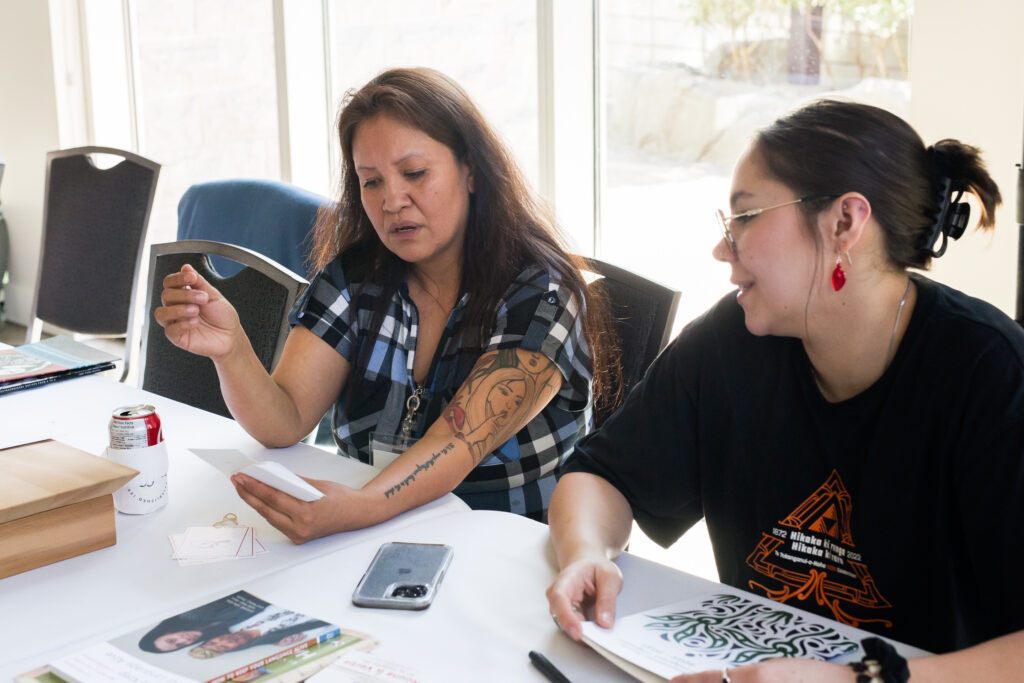Mentor-Apprentice Program (MAP) graduate and MAP coach Corey-Lee Philbrick weaves together language, art and culture while teaching both Secwepemctsín and hide-tanning
Teaching a Secwepemctsín hide-tanning workshop is an “incredibly powerful” experience, says Corey-Lee Philbrick of Williams Lake First Nation. The sharing of both language and arts skills is strengthening cultural connections for those in her community.

“You see a kid tanning a hide, speaking the words you taught them, and they are so happy. You watch them singing and picking up the drum, praying for themselves and for their family, and it changes everyone in the room. For those of us facilitating, we often have tears at the end of the day, just seeing the impact,” Corey-Lee says.
qweqwlút (speak)
Corey-Lee started her Secwepemctsín language journey with FPCC’s Mentor-Apprentice Program in 2021 after taking a Secwepemctsín language course at Simon Fraser University. Prior to entering the program, Corey-Lee only knew a few basic words in Secwepemctsín, taught to her by her grandmother. She was raised off-reserve but has since moved back. Not long after her return, she began the Mentor-Apprentice Program with her mentor, Cody William, also from Williams Lake First Nation. She is now one of FPCC’s regional MAP Coaches, supporting new MAP teams by sharing her knowledge and experiences.
Cody learned the language as an apprentice with his mother. He is currently a Language Administrator for the Spi7uy Squqluts Language & Culture Society and teaches Secwepemctsín at Thompson Rivers University. Cody and Corey-Lee share some family history connected to language loss as their mothers were childhood friends who attended residential school together. Cody and Corey-Lee’s work now contributes to restoring the language in their community.
Corey-Lee’s main reason for learning her language was so that she could teach it to her children and family members. While challenging at first, she soon found that her connection to cultural practices supported her language learning:
“At first I struggled with things like introductions and structures of command, but later in the program, I found my journey and that journey was through art and culture,” she says. “The first year I learned how to teach porcupine quill work, a dying artform. I learned the words and legends about the sets’u’ye (Secwepemctsín word for porcupine) and thought ‘There is more to learn here.’”
xqe7wéllen̓ (learn to do, learn to make something)
Incorporating cultural traditions into her language learning became the key to success for Corey-Lee. She went on to learn hide-tanning and its many words for animals and their parts, as well as the many special tools required.

“You can’t learn hide-tanning without learning the language,” Corey-Lee says. “There are over 100 words for the different types of tools that are used in hide-tanning: rock tools, fish tools, bone tools. Just so many specific words that we use. You learn the names of the animals, the different oils, the different types of water and frames, the bins and ways we contain the hides. Words that haven’t been used much in 50 to 60 years. The last time someone tanned a moosehide in my community was 30 years ago. I’m the first person to bring that back. I’m one of few, and the only female, who is a tanning hunter and trapper on my reserve. This will change in the next five years.”
Qweqwetsín r qelmúcw (The people pray)
Corey-Lee explains that in hide-tanning, it is important to lay tobacco and say a small prayer for the animal, which also requires language knowledge:
“We are taught to respect the animal you have killed. I cannot touch a hide without laying tobacco and saying a prayer. Throughout the process, we learn to properly carve, to preserve, or to smoke, to package and put away…. All of these words are in our language. Hide-tanning is one of the strongest things that we have. You can make blankets, jackets, gloves, hats, bags. And in teaching it, there is such a flow of information.”

Corey teaches various artforms to groups big and small: hide-tanning, bead work, medicines and porcupine quill work. She plans to visit local elementary schools next and has already had visitors from all over B.C. come and stay with her to learn.
Now an FPCC Mentor-Apprentice Program Coach, Corey-Lee helps others engaged in the program on their own learning journey. Her role is to support MAP teams in her region as they navigate the program she herself completed. When asked what she thinks about the immersion program, Corey-Lee says:
“Not learning the language is a trauma we have from the residential schools. Our language mentors and apprentices are breaking that chain. As they break that chain, you hear younger people running around speaking their languages. My biggest fear was that I was going to sound funny. You do sound funny at first,” Corey-Lee laughs, “because it is different. But after a while English will sound funny. It will flip on you.”

Corey-Lee says that many changes have come as a result of her learning Secwepemctsín.
“You change as a person,” she says. “You go into it thinking ‘I’m just going to learn a language,’ but you learn a culture at the same time and that changes your lifestyle. It changes the way you think, the way you eat and the way that you feel. It changes you and you also become part of the change.”
The Mentor-Apprentice Program (MAP) is a one-on-one language immersion program for people to become fluent speakers by bringing their language into their daily lives with activities in the home and on the land and waters.
The Mentor-Apprentice Program is made possible with funding from the Department of Canadian Heritage as a result of the Government of Canada’s Indigenous Languages Act, and the Ministry of Indigenous Relations and Reconciliation through the Province of British Columbia.
Learn More
View all FPCC grants currently accepting applications here.
Explore more stories about Language and other program areas here!
When possible, language recordings were shared from the public site Secwepemctsín site on FirstVoices.com using Soundcite.
Share Your Story!
Do you have a story about the work your community is doing to revitalize First Nations languages, heritage and arts in B.C.? We want to hear from you! Please send your story to info@fpcc.ca and check back as we post more stories about the good work being done across the province.
Connect with Us
To receive FPCC news and funding announcements, please sign up for our email list here.
Follow FPCC on social media for updates: Facebook | Twitter (X)| LinkedIn | Bluesky | YouTube

